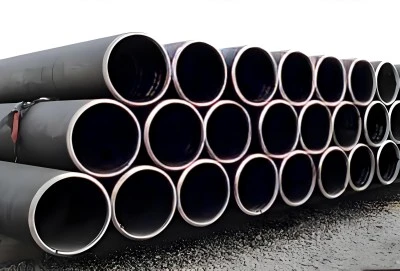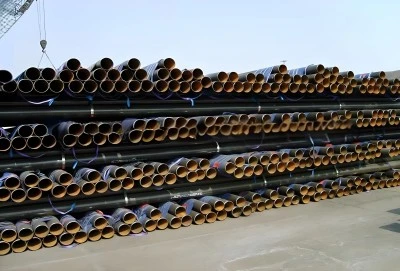The pressure rating of API 5L X42 pipe depends on several key factors, including the pipe's dimensions, wall thickness, and operating conditions. API 5L X42 is a medium-strength steel pipe grade with a minimum yield strength of 42,000 psi (290 MPa) and tensile strength of 60,000 psi (414 MPa). The typical working pressure rating for API 5L X42 pipe ranges from 740 psi to 2,160 psi (5.1 MPa to 14.9 MPa), varying based on pipe size and wall thickness. For example, a 24-inch X42 pipe with 0.375-inch wall thickness has a maximum allowable operating pressure (MAOP) of approximately 960 psi at ambient temperature. However, these values must be adjusted based on design factors, temperature derating, and specific application requirements according to applicable codes and standards.
|
|
|
What Is Pressure Rating And Why Is It Important?
Pressure rating represents the maximum internal pressure that a pipe can safely withstand under specific operating conditions. Understanding pressure ratings proves crucial for ensuring safe and reliable pipeline operations. The pressure rating incorporates various safety factors and considers potential failure modes to prevent catastrophic failures during service. Engineers and operators must carefully evaluate pressure ratings during the design and operation phases to maintain system integrity.
The importance of pressure rating extends beyond simple numerical values. It serves as a critical parameter in pipeline design, affecting material selection, wall thickness calculations, and overall system safety. Pressure ratings help determine the pipe's ability to contain fluids under pressure while maintaining structural integrity. They also influence maintenance schedules, inspection requirements, and operational limitations of the pipeline system.
API 5L X42 pipes undergo rigorous testing procedures to verify their pressure-bearing capabilities. These tests include hydrostatic testing, where pipes are subjected to pressures significantly higher than their intended operating pressure. The standard testing pressure typically ranges from 60% to 80% of the pipe's specified minimum yield strength (SMYS), providing a substantial safety margin for normal operations.
Factors Influencing The Pressure Rating of API 5L X42 Pipe
Multiple factors contribute to determining the pressure rating of API 5L X42 pipe. The pipe's diameter and wall thickness play fundamental roles in pressure capacity calculations. Larger diameters generally result in lower pressure ratings for the same wall thickness, while increased wall thickness enhances pressure-bearing capability. The manufacturing process, whether seamless or welded, can also affect the final pressure rating.
Material properties significantly impact pressure ratings. The X42 grade designation indicates specific minimum yield strength requirements, which directly influence the pipe's pressure-bearing capacity. The chemical composition and microstructure of the steel affect its mechanical properties and, consequently, its pressure rating. Quality control during manufacturing ensures consistent material properties throughout the pipe length.
Environmental and operational conditions must be considered when determining pressure ratings. Corrosion allowance, external loads, soil conditions for buried pipelines, and potential pressure surges all affect the final pressure rating. Design codes and standards provide guidelines for incorporating these factors into pressure rating calculations, ensuring adequate safety margins under various operating scenarios.
Typical Pressure Ratings For Common Sizes And Thicknesses of X42 Pipe
API 5L X42 pipes are available in various sizes and wall thicknesses, each with corresponding pressure ratings. Common pipe sizes range from 4 inches to 48 inches in diameter, with wall thicknesses varying from 0.156 inches to over 1 inch. The pressure rating calculations follow established formulas that incorporate pipe dimensions, material properties, and safety factors.
For example, an 8-inch X42 pipe with 0.322-inch wall thickness typically has a pressure rating of approximately 1,440 psi under standard conditions. A 16-inch pipe of the same grade with 0.375-inch wall thickness would have a pressure rating of around 1,180 psi. These values assume ambient temperature conditions and standard design factors as specified in applicable codes.
Pressure ratings must be adjusted based on service conditions and specific application requirements. The actual working pressure may be lower than the calculated maximum pressure rating due to safety factors, regulatory requirements, or operational considerations. Documentation of pressure ratings includes detailed calculations, testing reports, and certification documents.
Impact of Temperature On Pressure Rating
Temperature significantly affects the pressure rating of API 5L X42 pipe through its influence on material properties. Higher temperatures reduce the strength of steel, necessitating pressure rating adjustments. Industry standards provide temperature derating factors that must be applied to the base pressure rating for elevated temperature service.
At temperatures below ambient, the steel's strength typically increases, but other factors such as material toughness and brittle fracture resistance become more critical. Low-temperature applications require careful consideration of material properties and may necessitate additional testing or special material requirements. Temperature cycling can also affect long-term pressure rating through fatigue considerations.
Modern pipeline designs incorporate sophisticated temperature monitoring and control systems to maintain safe operating conditions. Temperature variations along the pipeline length must be considered in pressure rating calculations, particularly for long-distance transportation systems. Thermal expansion and contraction effects require additional design considerations beyond simple pressure rating calculations.
China API 5L X42 Pipe Supplier
The global market for API 5L X42 pipe includes numerous qualified manufacturers and suppliers. Quality control procedures, manufacturing capabilities, and compliance with international standards vary among suppliers. The selection of a reliable supplier ensures consistent product quality and adherence to specified pressure ratings.
LONGMA GROUP manufactures API 5L X42 pipe to both PSL1 and PSL2 specifications, maintaining strict quality control throughout the production process. Their manufacturing facilities utilize modern equipment and testing procedures to verify pressure ratings and other critical parameters. Quality documentation includes material certificates, testing reports, and traceability information.
For inquiries regarding API 5L X42 pipe specifications, pressure ratings, or other technical information, interested parties can contact LONGMA GROUP at info@longma-group.com. Their technical team provides support for pressure rating calculations and material selection based on specific application requirements.














